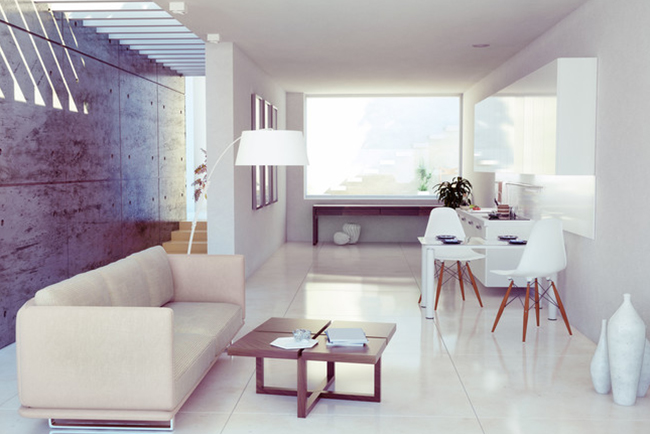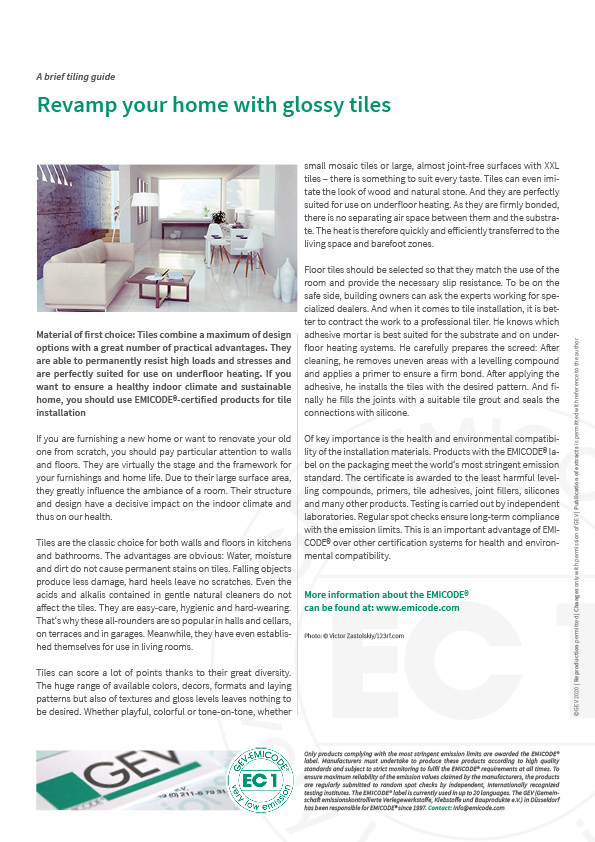Revamp your home with glossy tiles
A brief tiling guide
If you are furnishing a new home or want to renovate your old one from scratch, you should pay particular attention to walls and floors. They are virtually the stage and the framework for your furnishings and home life. Due to their large surface area, they greatly influence the ambiance of a room. Their structure and design have a decisive impact on the indoor climate and thus on our health.
Tiles are the classic choice for both walls and floors in kitchens and bathrooms. The advantages are obvious: Water, moisture and dirt do not cause permanent stains on tiles. Falling objects produce less damage, hard heels leave no scratches. Even the acids and alkalis contained in gentle natural cleaners do not affect the tiles. They are easy-care, hygienic and hard-wearing. That’s why these all-rounders are so popular in halls and cellars, on terraces and in garages. Meanwhile, they have even established themselves for use in living rooms.
Tiles can score a lot of points thanks to their great diversity. The huge range of available colors, decors, formats and laying patterns but also of textures and gloss levels leaves nothing to be desired. Whether playful, colorful or tone-on-tone, whether small mosaic tiles or large, almost joint-free surfaces with XXL tiles – there is something to suit every taste. Tiles can even imitate the look of wood and natural stone. And they are perfectly suited for use on underfloor heating. As they are firmly bonded, there is no separating air space between them and the substrate. The heat is therefore quickly and efficiently transferred to the living space and barefoot zones.
Floor tiles should be selected so that they match the use of the room and provide the necessary slip resistance. To be on the safe side, building owners can ask the experts working for specialized dealers. And when it comes to tile installation, it is better to contract the work to a professional tiler. He knows which adhesive mortar is best suited for the substrate and on underfloor heating systems. He carefully prepares the screed: After cleaning, he removes uneven areas with a levelling compound and applies a primer to ensure a firm bond. After applying the adhesive, he installs the tiles with the desired pattern. And finally he fills the joints with a suitable tile grout and seals the connections with silicone.
Of key importance is the health and environmental compatibility of the installation materials. Products with the EMICODE® label on the packaging meet the world’s most stringent emission standard. The certificate is awarded to the least harmful levelling compounds, primers, tile adhesives, joint fillers, silicones and many other products. Testing is carried out by independent laboratories. Regular spot checks ensure long-term compliance with the emission limits. This is an important advantage of EMICODE® over other certification systems for health and environmental compatibility.

Photo: ©Victor Zastolskiy/123rf.com
Material of first choice: Tiles combine a maximum of design options with a great number of practical advantages. They are able to permanently resist high loads and stresses and are perfectly suited for use on underfloor heating. If you want to ensure a healthy indoor climate and sustainable home, you should use EMICODE®-certified products for tile installation.

Do You Have Questions?
If you have questions about specific topics or if you would like to contact us for any other reason, feel free to contact us by phone, fax or e-mail.
Phone: +49 211 / 67931-20
Fax: +49 211 / 67931-33
info@emicode.com
Share article on Social Media:
